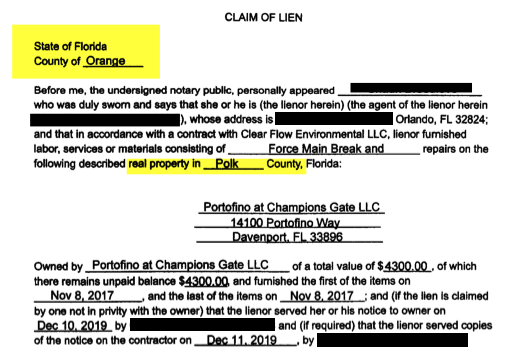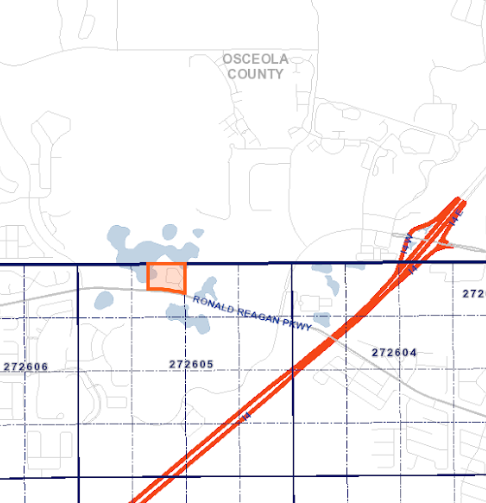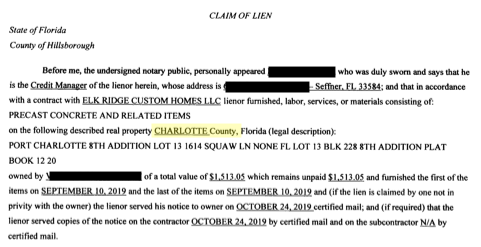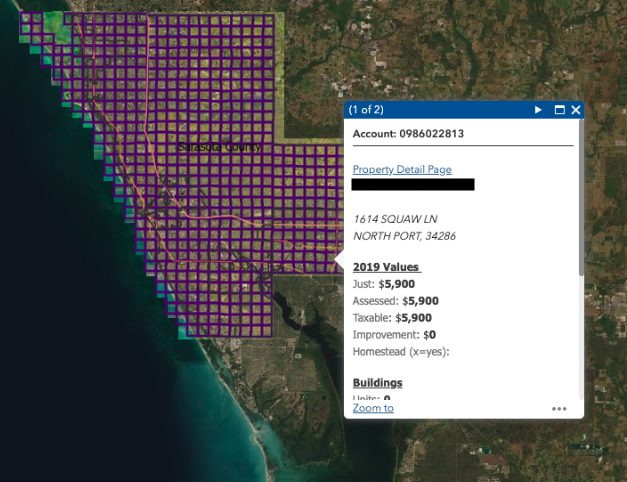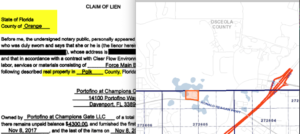
A mechanics lien is one of the most powerful tools that contractors can use to get paid. That’s true whether you’re in Florida or Alaska, or anywhere in between. But in order to be valid, it must be filed in the county where the project took place. Unfortunately, getting details wrong on a mechanics lien filing is an all-too-common mistake. And, potentially, a very expensive one.
Let’s face it: Most of us probably don’t know where our county border is physically located. Unless you spent a lot of time in your local property records office or reading county road signs, you probably don’t either. But if you’re a contractor, knowing what county you’re in may just be the difference between getting paid and losing your shirt on a construction project.
2 Florida liens, and 5 different counties
There are 67 counties in Florida, and only a handful of them have straight borders. If you’re just about anywhere in Florida, and ask five people which county you are in, you’re liable to get ten different answers. It can be difficult to know which county you’re in – especially if you’re anywhere near a county border. But figuring it out is an important part of securing your right to payment. Florida mechanics liens must be filed in the county where the project took place.
Below, we’ll examine two liens in Florida that look correct at first glance. But under closer scrutiny by Levelset’s research team, both of these liens were found to be filed with the wrong county. As a result, the property owners will probably challenge these liens – and may, get them discharged. This means the contractors will have to update information, prepare the lien forms again, and resubmit them in the correct county. That is, if they’re still within the deadline to file the lien claim. And that’s a big if.
Privacy note: While property records, including mechanics liens, are public information, we removed any personally identifying information, including individual names and addresses.
1. Portofino at Champions Gate
- Lien amount: $4,300
- Filed in: Orange County, FL
- Actual location: Polk County, FL
After going unpaid for a construction project on a property in Portofino at Champions Gate, this claimant filed their lien in Orange County. However, this property is actually located on the county line between Polk County and Osceola County. The jobsite in Davenport, FL is actually about 10 miles south of the Orange County border as the crow flies.
2. Port Charlotte or North Port?
- Lien amount: $1,513.05
- Filed in: Charlotte County, FL
- Actual location: Sarasota County, FL
In this case, the claimant wrote a parcel description in the lien claim document listed the city of Port Charlotte, which is Charlotte County. This could have easily confused the lien claimant and caused them to file the lien under Charlotte County. Yet, the job site was actually in North Port, FL, which is in Sarasota County. In fact, there’s only about five miles that separate Port Charlotte from the Sarasota County border.
Had the lien claimant tracked down the deed – another public document – they would have identified the correct county.
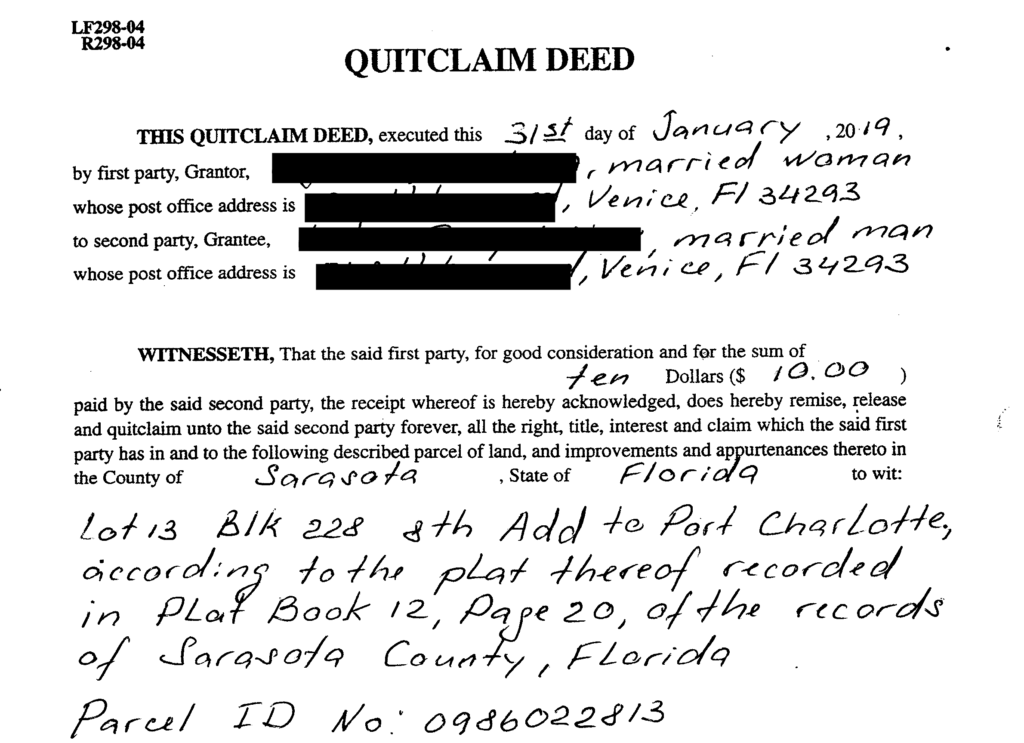
Getting the county right matters
Filing your lien in the wrong county is a pretty big mistake, because the lien will generally be unenforceable. Only the recorder’s office in the county where the property is located has jurisdiction over mechanics liens filed in that county. Ultimately, it’s the responsibility of the lien claimant to make sure that they file in the correct county. In both of the above cases, the county recorder accepted and filed the mechanics lien – even though the property wasn’t actually in that county.
The same holds true for every detail on your Florida lien claim form – it’s critical to get every piece of information correct before you file it. When the property owner and/or GC on the project find out that you filed a lien, they will try to find every mistake you made, and use every argument possible to get your lien claim dismissed.
Bad details can kill your lien deadline
In Florida, the deadline to file a mechanics lien is 90 days from the date of last furnishing. Generally, that means Florida contractors have 3 months from the last day they were on the job to file a lien. If you get the details wrong on your mechanics lien form, you may not find an error until after the deadline has already passed. If a GC or property owner spots a problem with your mechanics lien, they aren’t likely to challenge it until after the deadline – when you have no chance to fix the error and resubmit.

Discover how a Florida contractor’s average DSO went from 60 days to 14 days after sending notices on every job.
Florida county recorders aren’t lien detectives
If you’re lucky, the county recorder may catch an error like this for you, giving you time to file a corrected form. But if you’ve ever visited a county office, you probably know well how overworked they often are. If they have a backlog of documents to file (and they probably do), they aren’t going to comb through your mechanics lien form to check that you’ve crossed your t’s and dotted your i’s. They’ll probably do a quick scan to make sure your handwriting is legible, that you completed all of the necessary fields, and that it meets the formatting requirements.
How to find the right county to file your Florida mechanics lien
Contact the County Assessor Office
The first step a contractor should take to determine the county they’re working in is to contact the county or town assessor’s office. In Florida, most county assessor office websites – if not all – publish an online searchable database of properties. Before you file a lien, verify that the property is actually where you think it is.
In these cases, websites for both the Polk County Assessor Office and Sarasota County Assessor Office include property search options and a map search to help contractors double check their project’s county location before submitting a lien.
Look at the property deed
A property’s deed is usually public record, and can be accessed through the county recorder’s office where the property is located. In some cases, you can view the deed publicly online for free. In the case of these liens, both the Polk County and Sarasota County clerk’s offices allow you to search and view deeds online. Contractors can either go to their county clerk’s office to request a deed, or hire a third party company that will take care of the process for them.
When in doubt, file in both counties
In some cases, you may be working on a property that straddles or is dangerously close to the county line. When in doubt, your best bet might be to file a mechanics lien in each county. This will cost a bit extra, since you’ll be paying for filing twice, but it’s a good way to ensure that the lien is filed with the correct office.

The #1 reason liens get rejected: Bad information.
Learn more about job research team. We'll track down and verify all of the job information you need to complete your form and file a valid mechanics lien.


